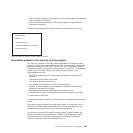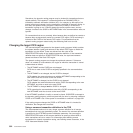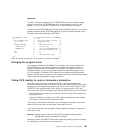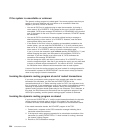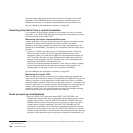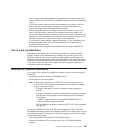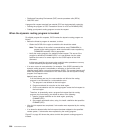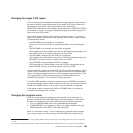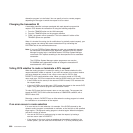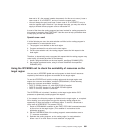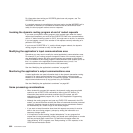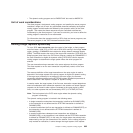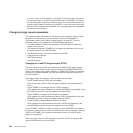
Changing the target CICS region
The communications area passed to the dynamic routing program initially contains
the system identifier (sysid) and netname of the default CICS region to which the
link request is to be routed. These are derived from the value of the
REMOTESYSTEM option of the installed program definition. If REMOTESYSTEM is
not specified, or there is no program definition, the sysid and netname passed are
those of the local CICS region.
The dynamic routing program can change the sysid and netname.
5
If it does so
when it is invoked for route selection, the region to which the link request is routed
is determined as follows:
v The NETNAME and the SYSID are not changed.
CICS tries to route to the SYSID as originally specified in the communications
area.
v The NETNAME is not changed, but the SYSID is changed.
CICS updates the communications area with the NETNAME corresponding to the
new SYSID, and tries to route the request to the new SYSID.
v The NETNAME is changed, but the SYSID is not changed.
CICS updates the communications area with a SYSID corresponding to the new
NETNAME, and tries to route the request to the new SYSID.
v The NETNAME is changed and the SYSID is changed.
CICS overwrites the communications area with a SYSID corresponding to the
new NETNAME, and tries to route the request to that new SYSID.
You can route DPL requests over both IPIC and ISC over SNA connections. If there
is both an IPIC connection and an ISC over SNA connection to the selected target
region, and both are named the same, the IPIC connection takes precedence. That
is, if remote SYSID “CICB” is defined by both an IPCONN definition and a
CONNECTION definition, CICS uses the IPCONN connection.
If the NETNAME specified is invalid, or cannot be found, SYSIDERR is returned to
the dynamic routing program—which may deal with the error by returning a different
SYSID or NETNAME—see “If an error occurs in route selection” on page 600.
If the routing program changes the SYSID or NETNAME when it is invoked for
notification, the changes have no effect.
Changing the program name
When the routing program is invoked for route selection or for notification of a
program-link request, the DYRLPROG field in the communications area contains
the name of the program to be linked, obtained using the following sequence:
1. From the REMOTENAME option of the installed program definition
2. If REMOTENAME is not specified, or there is no program definition, from the
PROGRAM option of the EXEC CICS LINK command.
When it is invoked for routing
6
(not for notification of a statically-routed request),
your routing program can, by overwriting the DYRLPROG field, specify that an
5. If the REMOTESYSTEM option of the program definition names a remote region, the routing program cannot route the request
locally.
6. By “invoked for routing” we mean both “invoked for route selection” and “invoked because an error occurred in route selection”.
Chapter 17. Writing a dynamic routing program
599



